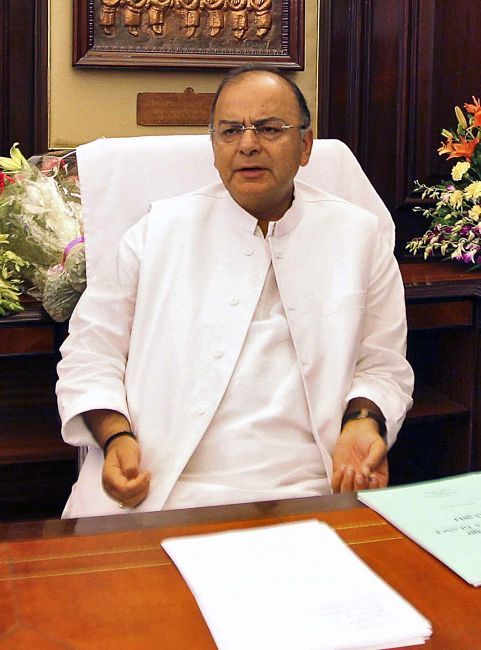 In an interview with Lok Sabha TV, Finance Minister Arun Jaitley says while pushing for growth, he has tried to ensure the Budget does not compromise on social sector spending.
In an interview with Lok Sabha TV, Finance Minister Arun Jaitley says while pushing for growth, he has tried to ensure the Budget does not compromise on social sector spending.
Edited excerpts:
Will it be correct to say that the 14th Finance Commission recommendations have impacted your taxation strategy a little bit? You have abolished wealth tax, which was a sharable resource, but you have replaced it with a 2 per cent extra surcharge, which you will not share. Similarly, if you look at petrol and diesel, where you have increased the cess, which will again come to you, so taken together Rs 80,000 crore (Rs 800 billion) of extra revenue annually and Rs 9,000 crore (Rs 90 billion) of surcharge. . .
In your first question on wealth tax, you may not be very accurate.
My thinking was, one, why must I have a high-cost, low-yielding tax.
Lakhs of people file returns, but they understate the value of their jewellery and properties.
The whole energy of the department is spent on those lakhs of returns and finally we end up getting Rs 900 crore (Rs 9 billion) or Rs 1,000 crore (Rs 10 billion) from the whole wealth tax with all its attendant consequences.
It’s a very high-cost tax and very low-yield.
Therefore, rather than allow that to continue, at some stage after Goods and Services Tax, a large number of cesses are going to be subsumed in the taxes.
Therefore, I decided to tax the super rich who can afford to pay, so I increased the surcharge by 2 per cent.
By sacrificing the Rs 1,000 crore (Rs 10 billion), saving so much of governmental energy, eliminating corruption and harassment, I end up collecting Rs 9,000 crore (R 90 billion) instead of Rs 1,000 crore (Rs 10 billion).
But the states lose out completely. . .
But the states have also gained so much.
The idea was not to make the states suffer -- we realised that when we were trying to raise the states.
Budget 2015: Complete Coverage
When oil prices come down, the question was, how will that money be shared?
We have passed that benefit to the consumer 11 times; on one or two occasions the oil companies have retained the benefit and they retained it because they are suffering from inventory losses.
They buy at $80 and they are now selling at $60, so Rs 30,000 crore (Rs 300 billion) was the inventory loss of oil companies.
The third area is the money coming into central revenue, either by excise or by tax.
We now intend a large part of this money should go into highways, it is part of my infrastructure priority.
You have proposed to reduce the rate of corporate tax from 30 per cent to 25 per cent over four years and have also hinted there will be pruning of exemptions. Is there a timeline for this?
Ideally, I would have loved to do it this year.
Why do I want to bring corporate tax from 30 per cent to 25 per cent?
I have to attract investment in this country -- not just international but domestic.
We have 30 per cent plus surcharges, plus cess, etc.
Look at all the Association of Southeast Asian Nations countries.
They average 21.9.
Our competing economies are almost 10 per cent cheaper than us when it comes to the cost of tax.
So, investors will ask why should I invest in India?
My own investors are setting up units in other ASEAN countries. I lose on two counts: My image of a high-tax country; second, on account of these exemptions what is 30 per cent I end up getting only 23 per cent.
So in an ideal tax structure you bring the rates down, make them globally competitive and phase out the exemptions.
Budget 2015: Complete Coverage
There seems to be a new development ideology for the country. It seems to be based on devolution and not on grants. There is greater emphasis in your Budget on creating entrepreneurs. Can you elaborate?
As far as devolution is concerned, I think discretions must end.
It shouldn't be like I will give to a particular state because it is a Bharatiya Janata Party state and I won't give money to a Congress state.
I think this is a story of the past.
Both by the Finance Commission and by the Budget, the non-National Democratic Alliance states are the greater beneficiaries, because on some developmental criteria or the need to spend more on them, the prime minister has said the eastern part of the country is less resourced, or maybe more resourced but less affluent.
Now, we have to walk the talk.
What is the central message of your Budget?
There are many positives, as commentators have pointed out -- the infrastructure investment outlay has gone up, tax administration has been improved.
But there are voices on Twitter, where some are saying is it a middle-class Budget or an Amartya Sen Budget.
Some have said you have deferred your fiscal consolidation plan. . .
This is the year when we inherited the economy; so we had to work to change the entire global investor attitude towards India.
We had to clear the backlog of decisions, we had to clear the mess lying on the table. That's what we have done and that's what has got us positive results.
Also, it was not an extraordinary year for the Indian economy -- it was a modest year. I think from here the time for take-off comes.
The entire architecture of the Centre-state financial relationship has been redefined.
The states were getting 32 per cent plus some extras.
Now they get 42 plus five: 47 per cent.
So, of the tax that we collect, 47 per cent goes to the states.
I am straight away down by 10 per cent.
If you look at the all-India picture of total national taxes, central and state, the states used to get 49 per cent and the Centre 51 per cent till last year.
This year, it's 62 in favour of the states. So, the states are financially more powerful.
Now how do I make up for the loss of revenue?
The size of my case gets shortened, therefore we have to grow faster next year.
If we go on the projected growth rate of 8 per cent-plus our revenue projection is about 15-plus (15 to 16 per cent).
Last year’s projection was overstated because 4.1 per cent was the fiscal target set not by me but by Mr Chidambaram, which I had adopted. Half way through the year, I couldn't change it.
Therefore to meet 4.1, what is the amount required?
There are only two ways through which you can meet the fiscal target -- you either earn more or spend less.
Last year, we did both.
This year is my year, and, therefore, I have to be transparent about every fact.
If my revenues go up by 15.9 per cent or so as we are projecting, with this growth rate, I make up for the shortfall in terms of the Centre’s cake by tax buoyancy.
Image: Finance Minister Arun Jaitley; Photograph: Reuters










 © 2025
© 2025